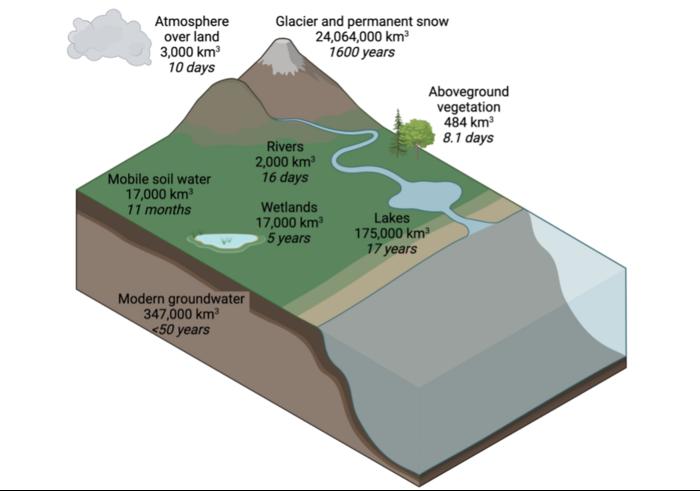
A groundbreaking study from the Schmid College of Science and Technology at Chapman University has illuminated a critical, yet hitherto overlooked, aspect of the global water cycle. Published recently in the journal Nature Water, this innovative research provides comprehensive global estimates of water storage within Earth’s vegetation and the pace at which this water traverses through plants. Such insights represent a significant leap in our understanding of the water cycle, particularly as it is increasingly impacted by climate change and changing land use.
The study indicates that Earth’s vegetation stores approximately 786 cubic kilometers of water. This may seem negligible, as it constitutes a mere 0.002% of the total freshwater available on our planet, but the implications of this finding are profound. The transit time of water through plants—how long it takes for water to move from the ground, through vegetation, and back into the atmosphere—is astonishingly quick. According to the lead author Dr. Andrew Felton, who conducted this research while on a U.S. Department of Agriculture Fellowship at Chapman University and is now a professor at Montana State University, the transit time can be as little as five days in agricultural areas. This is in stark contrast to the significantly longer periods seen in other natural reservoirs; for instance, water in lakes takes an estimated 17 years to cycle, while that trapped in glaciers may remain for as long as 1600 years.
These findings illuminate the dynamic role of plants in the water cycle, emphasizing that they are not merely passive vessels but rather active participants in a global exchange of water. With such rapid turnover rates, it is evident that vegetation plays a crucial role in returning moisture to the atmosphere, which could have significant implications for weather patterns, climate models, and water management practices. This rapid cycling suggests that changes in vegetation, be it through deforestation, urbanization, or agricultural practices, could drastically alter local and global hydrological processes.
The research team successfully combined advanced methodologies that include satellite data from NASA’s Soil Moisture Active Passive (SMAP) mission, which was originally designed for soil moisture measurements. The Chapman researchers, however, turned this mission’s intention on its head by applying the insights on vegetation’s role in soil moisture dynamics to better understand the global water cycle. By examining how much water is stored in plants alongside data on water leaving plants during transpiration, they compiled five years’ worth of detailed insights on monthly water storage and transit times, with a remarkable spatial resolution of just 9 square kilometers.
The results reveal tremendous variability in water transit times across different ecosystems and seasonal periods. For example, in regions classified as croplands, the data show that water can be cycled in less than a day during peak growing conditions—a stark contrast to the slower moving nature of water in forests and wetlands. Dr. Gregory Goldsmith, a senior author and an Associate Professor of Biological Sciences at Chapman University, highlights how the observations indicate a trend of homogenization across global croplands, suggesting that land use changes increasingly modify the natural dynamics of the water cycle, leading to an intensification of extreme weather events such as heavy rainfall.
Another critical element of the study focuses on how the transit of water through plants is sensitive to climatic disturbances. According to Felton, factors such as deforestation, drought, and wildfires not only affect the amount of water stored in vegetation but also fundamentally alter the time it takes for that water to travel through the cycle. This realization underscores the importance of safeguarding our plant ecosystems—not just for biodiversity but as critical components of the global hydrological framework.
The researchers opine that an increased awareness of the actual transit times of water within the vegetation sector could influence global water resource management policies. Integrating plant dynamics into water cycle understanding promises to improve predictive capabilities for hydrological responses to climactic shifts, thereby enhancing our preparedness for changing weather patterns and ensuring sustainable water use.
In the grand scheme, the findings encourage a reevaluation of how ecosystems are represented in water cycle models. Historically, plants have often been sidelined in diagrams and discussions about the hydrological cycle. The study challenges this oversight, positing that vegetation is an integral and interactive component that merits greater attention in both scientific and educational contexts.
In summary, the work conducted at Chapman University represents a pivotal shift in ecological research and climate science. Understanding how water flows through vegetation not only supports academic inquiry but has tangible implications for environmental policy and our global approach to sustainability. As populations grow and climates shift, having a nuanced grasp of the relationship between vegetation and the water cycle could spell the difference in our efforts to adapt to and mitigate the impending challenges that await us.
As researchers like Felton and Goldsmith continue to unveil the intricacies of the water cycle, it becomes increasingly evident that addressing environmental concerns through a multidimensional lens—one that includes the dynamic contributions of plants—will be essential for the survival of both ecosystems and human populations around the globe.
Subject of Research: Water transit times through vegetation
Article Title: Global estimates of the storage and transit time of water through vegetation
News Publication Date: January 9, 2025
Web References: Nature Water
References: Felton, A., Goldsmith, G. (2025). Global estimates of the storage and transit time of water through vegetation. Nature Water. DOI: 10.1038/s44221-024-00365-9
Image Credits: Chapman University
Keywords: Water cycle, vegetation, climate change, transit time, water storage, ecological research, hydrology, land use change, Chapman University.





